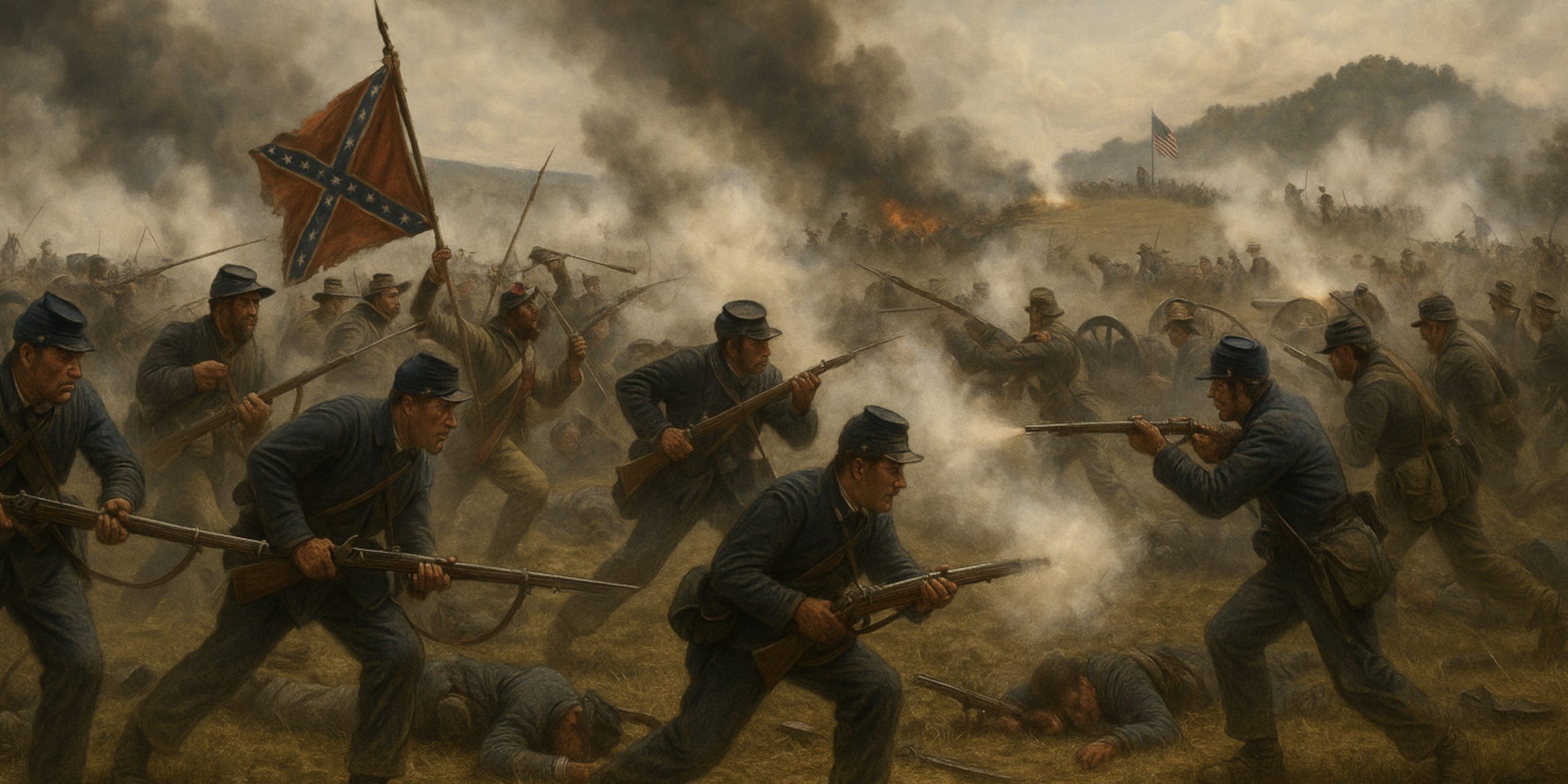
The Battle of Gettysburg, fought from 1 to 3 July 1863, was the largest engagement of the American Civil War and a turning point in the conflict. Union forces under Major General George G. Meade repelled the Confederate Army of Northern Virginia led by General Robert E. Lee in a fierce three-day struggle in Pennsylvania. The battle halted Lee’s invasion of the North and inflicted heavy casualties on both sides.
Background
By mid-1863, Lee sought to carry the war into Union territory to relieve pressure on the war-torn South, gather supplies, and potentially secure European recognition for the Confederacy. After his victory at Chancellorsville, he moved north through the Shenandoah Valley into Maryland and Pennsylvania. Union forces, reorganised under Meade just days before the battle, marched to intercept him.
Forces
Overall Strengths
| Side | Estimated Strength | Commander |
|---|---|---|
| Union | 93,900 | Major General George G. Meade |
| Confederate | 71,700 | General Robert E. Lee |
Leaders and Troop Composition
| Side | Army & Corps Commanders | Composition |
|---|---|---|
| Union | Army of the Potomac – Maj. Gen. George G. Meade | 7 infantry corps, 1 cavalry corps, artillery reserve |
| Confederate | Army of Northern Virginia – Gen. Robert E. Lee | 3 infantry corps, 1 cavalry division, artillery battalions |
Arms and Armour
Union Army
- Small Arms: Springfield Model 1861 rifled muskets, Spencer repeating rifles (limited issue), Colt revolvers.
- Artillery: 3-inch Ordnance rifles, 12-pounder Napoleons, Parrott rifles.
- Uniform: Dark blue wool tunics and trousers, kepi or forage caps, leather cartridge boxes and belts.
- Protection: Minimal body armour, reliance on cover and entrenchments.
Confederate Army
- Small Arms: Enfield Pattern 1853 rifled muskets (imported), captured Springfield rifles, assorted smoothbores.
- Artillery: Mixed calibre, including 12-pounder Napoleons, 10-pounder Parrott rifles.
- Uniform: Grey or butternut jackets, slouch hats or kepis, varied due to supply shortages.
- Protection: No formal armour, improvised fortifications and natural cover.
Battle Timeline
1 July 1863 – Confederate forces clash with Union cavalry west of Gettysburg. Union infantry reinforcements arrive but are driven back through the town to defensive positions on Cemetery Hill.
2 July 1863 – Lee launches coordinated attacks on both Union flanks. Fierce fighting at Little Round Top, Devil’s Den, the Wheatfield, and the Peach Orchard. Union lines hold despite severe losses.
3 July 1863 – Lee orders a massive frontal assault on the Union centre, known as Pickett’s Charge. Around 12,500 Confederate troops cross open ground under heavy fire and are repelled with devastating casualties.
4 July 1863 – Lee withdraws towards Virginia. Meade does not immediately pursue, allowing the Confederate army to escape across the Potomac.
Archaeology
Archaeological work at Gettysburg has uncovered:
- Minie balls, artillery fragments, and uniform buttons across the battlefield.
- Remains of temporary field fortifications and artillery emplacements.
- Battlefield medical tools and personal items from both armies.
- Evidence of rapid battlefield burials later reinterred in the Soldiers’ National Cemetery.
These finds provide insight into troop movements, firing positions, and the brutal conditions of the fighting.
Contemporary Quotes
Union Private G.W. Nichols, 61st Georgia Infantry (Confederate perspective):
“Men were torn to pieces by cannon balls and musketry, and the air was full of flying missiles.”
Union Major General Winfield S. Hancock:
“The musketry was so close that the opposing lines looked like solid walls of fire.”
President Abraham Lincoln (Gettysburg Address, November 1863):
“The world will little note, nor long remember what we say here, but it can never forget what they did here.”
Legacy
Gettysburg was the bloodiest battle of the Civil War, with around 51,000 casualties. It marked the last major Confederate offensive in the North. The Union victory, coupled with the fall of Vicksburg on 4 July 1863, boosted Northern morale and weakened Confederate hopes of foreign recognition. The battlefield is now preserved as Gettysburg National Military Park, visited by millions each year.
Watch the documentary:



